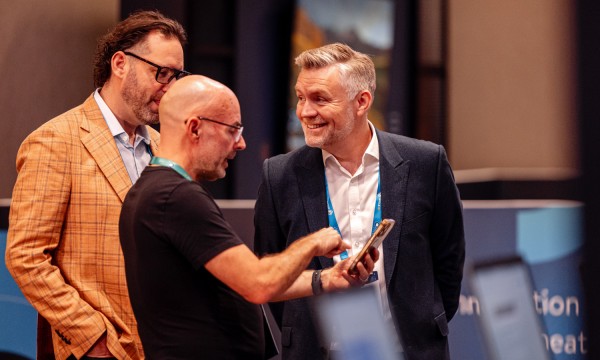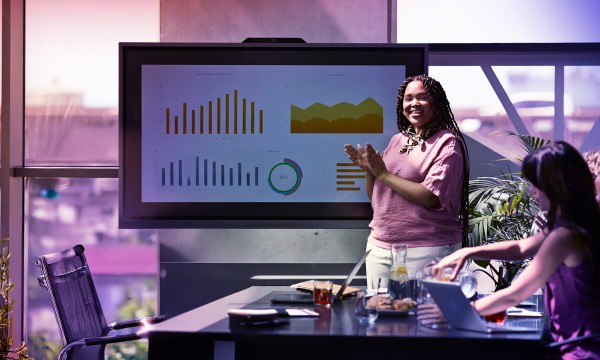ABM & Events: Driving ROI and Maximizing Event Success

{"preview_thumbnail":"/sites/default/files/styles/video_embed_wysiwyg_preview/public/video_thumbnails/qwFVYVAdgBg.jpg?itok=j4OuIIul","video_url":"https://youtu.be/qwFVYVAdgBg","settings":{"responsive":false,"width":"854","height":"480","autoplay":false},"settings_summary":["Embedded Video (854x480)."]}
Episode description
ABM has become a buzzy word in the marketing world.
But what exactly does it mean?
In this episode, EJ Oelling, VP of ABX at 6sense, breaks it down. She explains the difference between ABM and ABX while emphasizing the importance of bringing the experiential factor to ABM in events.
But what about the data?
Data is a crucial component of any successful ABM strategy, and EJ shares the five steps that drive their approach at 6sense.
It's not just about throwing a party anymore – it's about knowing your audience and getting the right return on your event investment.
In this episode, you’ll learn:
- The difference between ABM and ABX
- The role of technology in ABM events
- The importance of data in ABM and events
Things to listen for:
- [02:07] The difference between ABM and ABX
- [04:35] How ABM is driving pipeline
- [06:13] Why leveraging data enhances marketing strategy's effectiveness
- [10:09] How to get the greatest ROI in events
Meet your host
Alyssa Peltier, Director of Market Strategy & Insights, Cvent Consulting
Meet your guest speaker
EJ Oelling, VP of ABX at 6sense
EJ Oelling: We're pulling out the segments. We're looking at our keywords. We're pulling out all the different data. We know we're looking at our customers. We're really, really that goes back to the data plus experience equals pipeline. We're really looking at the data to see who's engaged to really drive home to make sure that our events are touching everybody, because we really need the ROI and events. You just can't throw a party anymore and hope you're going to get success. You have to know that you're getting the return on that investment.
Alyssa Peltier: Great events create great brands, and it takes a village to put on an event that engages, excites, and connects audiences to your brand. And we're that village. I'm Alyssa.
Paulina Giusti: I'm Paulina.
Rachel Andrews: And I'm Rachel.
Alyssa Peltier: And you're listening to Great Events, the podcast for all people interested in events and marketing.
Alyssa Peltier: Hello, everyone. What has been going on in this wide, wide world of events? My name is Alyssa once again, and welcome to this week's episode of Great Events, a podcast by Cvent. Today's theme and topic of conversation is related to ABM, which is quite a buzzy word, and it has been in the world of marketing for the past few years. If you don't already know, ABM stands for account based marketing. And here to talk to us more about ABM and specifically how it applies to events and your event programs, we have a very special guest speaker, EJ Oelling, VP of ABX at 6sense, which is an organization that knows a little bit of something about ABM as it is a leading platform in the ABM technology space. So, EJ. Welcome to the show. Let's start with a little bit of introduction, shall we?
EJ Oelling: Hey, thank you so much for having me. Yes, I am EJ Oelling, the VP of ABX. We only do initials, apparently, when it comes to my role here. Yes. ABM to ABX. And we'll dive in about what the X means for the ABX part there. But I work at 6sense, so 6sense is a ABM platform. We really look at revenue AI. We kind of see where everybody is to help maximize your ROI so we can dive into that a little bit more. But we're here to talk about fun event stuff.
Alyssa Peltier: I love it. Okay, let's start with that. First question. What is the difference between ABM and ABX? Since this is, your know, the VP of ABX, tell our listeners a little bit about what that means for your organization and for the broader market at large.
EJ Oelling: Absolutely. So, as you mentioned, so ABM, so account based marketing, everybody's using that terminology. We bring the X factor. To me, it's experiential. It's bringing that experience. I truly believe that account based marketing needs that touching point. You need that moment. And so we bring the experience so that could be anything from the event. It could be a go to market. It's kind of having that touch point there.
Alyssa Peltier: EJ, what does your team look like and how does that work in conjunction with your larger ABM strategy? At 6sense specifically, so 6sense specifically.
EJ Oelling: So we have partner marketing, we have event marketing, and we have go to market strategy. So we kind of bring them all together and they make one big pie.
Alyssa Peltier: Nice, interesting. And you're responsible for all of those parties?
EJ Oelling: All of those parties. Interesting because it takes a little bit of mix of everything. So we don't have traditional field marketing. So many people might say, oh, I only have field marketing. So I totally get that. So you have your event people who do your menu venue. They hate being called that, but let's just call it for real. So you your menu venue, event logistics, you have your go to market strategy, you have your field marketer who kind of rocks in the middle.
EJ Oelling: So sometimes they take a little bit of an event person and a little bit of a go to market person. You make your field marketer and then you have your partner marketing person who sits across horizontally because you need a little partner marketing across sprinkled in the middle. And then that together you make your ABX strategy interesting.
Alyssa Peltier: Okay, that tracks with how we're structured at Cvent. I wish we had other hosts on this podcast because they'd have a lot of organizational questions for you, but I think that makes sense for our listeners too, who know a little bit about how Cvent organizes its team, since we do talk quite heavily about ourselves on the podcast as well. So that makes sense.
Alyssa Peltier: ABM versus ABX. Let's go a little bit deeper on ABM. So just kind of this bigger picture kind of concept. Can you unpack that for us? And specifically how 6sense helps organizations have a better ABM strategy?
EJ Oelling: 100%. So we really believe in the five steps, so we break it down into it's. Data plus experience equals pipeline. So if you read our book, you can kind of go into more detail. But we only have ten minutes here, so then we get really quick. So we really look at the data. So the data really drives. Who's going to come to your event? Who do you want there? Who's your targeted audience? What do you want to get out of it? So you look at your data, then you tie in, what is your experience? Are you doing an email campaign? Are you doing a dinner? Are they your targeted account where you're doing all the bells and whistles? Are you just trying to get them, just trying to recognize them as an audience? You're trying to figure out who they are. So you use your data to figure out what your audience is going to be, then you figure out what the experience is going to be that ultimately is going to drive your pipeline. That to me is just really what ABM is, to drive your pipeline at the end of the day.
Alyssa Peltier: Can you see a space or can you kind of help us understand how 6sense or an ABM like platform works in conjunction with a technology provider like Cvent in order to have a better strategy? And you may or may not be there yet because I know that this may be a new undertaking for you guys too, but I'm curious what your thoughts are around event technology as part of the ABM platform play.
EJ Oelling: Oh, that's a big one to noodle. I mean, I think there's a good play in there. There's definitely a way to reach your audience that's different. You know what I mean? And I think it all boils down to just knowing your audience and that's the data piece to it. I mean, I bet you would probably think the same. It's knowing who your audience is going to be. Are you targeting the right personas? Are people really looking? It's knowing people where people are in their buying cycle. And I think that's really where 6th Sense can help a lot is are people really looking at your product? Are you talking to people really in the right buying stages? Historically, it used to be I want everybody that's out there now I can really get targeted. Is it the right person on your buying team that I'm talking to? And that's probably something that Cven is really looking at. Is it the right person that's buying now that's out there too? So I think that's probably where we would connect the most.
Alyssa Peltier: I love that. I love that response that it really helps you have a more intelligent right offer or right event or right experience to your point to the right people at the right stage. And we talk about that a lot in our discussion around how events are a channel and how you can amplify and maximize this as an opportunity. But if you aren't leveraging the data from your broader marketing strategy, it's kind of all for not right and you kind of alluded to this, but broad marketing. Pray for the best. Let's monitor the conversions, but I think you're assuring better conversion rates when you're looking at the data before you actually hit send or launch on your approach to things. I know I said we're going to take it off script, but I love this. It's a good conversation for us to have.
EJ Oelling: And I think we have to be smarter about it now too. I mean, budgets are tighter, the economy is different, and we're all kind of targeting very similar people too, right? And people are we need to just know who we want to go after, who are the right buyers that are out there as well. And so I think we just have to target we have to be smarter about our data.
Alyssa Peltier: Let's talk about the inverse on that conversation too, because events themselves have the opportunity to enrich that data set as well, right? It's not just the acquisition piece. It's also how do we take the insights, the engagement that we have at an event which technology like Cvent can help pass back into a platform like Six Sense. I'm wondering how your team looks at that EJ and how you kind of think through the concept of event led growth, right where the events are helping to build that bigger picture. Is that something that you're looking at?
EJ Oelling: Yeah, I mean, we are always looking at how do we take that information and then grow differently? How do we think differently and think outside the box, you know what I mean? How do we not just do that email? How do we take that data and pivot with it? And so I think that event led growth is a different approach. I actually think it's the approach we've probably tried five years ago and didn't tackle the right way, and now we get to do it again a little bit differently. So I think we're getting back into the groove. I think we're getting back post pandemic and going that way. I'm interested to see where the next year and a half takes us.
Alyssa Peltier: Have you seen any findings in just kind of dissecting your event programs of the last two years? Are there any things that are working really well? Are there any things that are underperforming that you're kind of like, we might need to go back to the drawing board. I know we're in like a big strategic planning phase of the year as well, so I'm sure you're in that kind of assessment frame of mind.
EJ Oelling: I mean, if you would have asked me years ago, I would have said, like, no one's going to go to sporting events. No one wants to do that. Stop spending your money. Now people want to do that. People want to be engaged. They want to do those one on one activations. They want to do the suites, they want to do that stuff. I would have told my teams years ago, we are not spending money on that. Now they want to spend money on that. Now. They want to do those highly targeted one to one, one to few activations. That's your ABM. That's your ABX. You know what I mean? That's coming back again.
Alyssa Peltier: Yeah, it seemed like the intersection right there. Yeah.
EJ Oelling: All the clothes I wore in 1997, they are, you know what I mean? That is kind of profound. So it's like those kind of things. So that's that event led there. I think the large, big events, the big part, I don't know if those are ever really going to come back again. I think that's few and far in between, but I do find the really highly targeted direct mail, that kind of stuff, I don't think that's going to go away and I'm interested to see how that's going to change and even get better over the next year and a half.
Alyssa Peltier: I love that. I think that's really insightful and leading, right? Like, those kind of what's trending right now. Let's talk about trends for a second because I know that sixcents has been real popular in the trade show space and doing some really interesting, let's say, offsite activations. I'm assuming that your team's responsible for those. Can you talk about how you guys think about that and maximizing your impact beyond we did this on a previous podcast. But beyond the booth, right? Like thinking beyond the ten x ten, the traditional. What goes into that strategy, EJ?
EJ Oelling: I'm a full believer that Booth is great, but that's not where you're going to get your return on investment, unfortunately. I mean, maybe some people do. I don't necessarily so for me, it's, let's get the meetings, let's get that one on one impact. Let's find how we're going to make some noise. So maybe we find our brand in weird places. Maybe we park a truck in front of other places. We do ways to make noise. We built Club Six, which is our executive lounge. I mean, that is like our club. Six is where you relax and recharge and you feel like you're part of our brand and you feel like you're part of Six Sense. That is super important to us, that you walk away with a little pop of teal. It doesn't have our Six on it, but you know that you're part of the 6th Sense brand when you're part of it. We work really hard to think of ways that you walk away, feel like feeling like you're part of 6th Sense. How do we come up with the crazy? I literally sit down with my team and I say, let's think of the crazy. Like, what is the most obscure word thing you could do? We go through the TikTok, we go through Instagram. My team is all different ages, you name it. We just kind of put together and then we think of the fun and we think of what are those moments that everyone's going to remember? And that's the key.
Alyssa Peltier: Let's peel it back to ABM here, right? So how are you identifying those that you'd want to even meet with on site at those particular experiences and you're using at 6sense?
EJ Oelling: We're pulling out the segments. We're looking at our keywords. We're pulling out all the different data. We're looking at our customers. That goes back to the data plus experience equals pipeline. We're really looking at the data to see who's engaged to really drive home to make sure that our events are touching everybody because we really need the ROI and events. You just can't throw a party anymore and hope you're going to get success. You have to know that you're getting the return on that investment.
Alyssa Peltier: And to the right people, right? And it starts with the data. To the right people at the right time, with the right experience.
EJ Oelling: 100%.
Alyssa Peltier: I think that is a perfect way to cap off this conversation. We start and end with ROI with every conversation. Right. So, EJ, thank you so much for this great, quick hitting conversation. Really appreciated the conversation today. Would love to have you on the podcast again. Perhaps we can continue this. Once again, thank you to all of our listeners for joining this week's episode of the Great Events podcast.
Alyssa Peltier: If you have any topics or people that you'd like for us to add to our 2023 season, which is almost coming to an end, perhaps we should talk maybe about 2024 now. DM us on LinkedIn, instagram us, or go ahead and send us a note at greatevents@cvent.com. Once again, thanks for tuning in and we'll see you next time.



